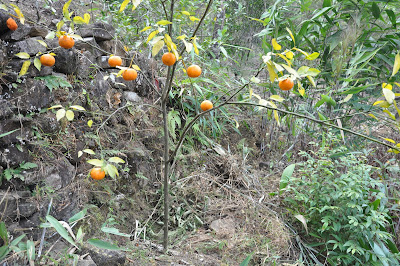 |
| Director of Agriculture, Meghalaya Dr.R.B.Dympep speaking during the launch |
The Centre for Development of Advanced Computing(CDAC) Mumbai and Directorate of Agriculture, Meghalaya today the 29th Nov. 2012 launched an Intelligent Advisory System for Farmers (IASF), which is a web based advisory system for answering queries related to farming activities and IASF mobile service, at the Seminar Room of the Directorate of Agriculture in Shillong.
The Inaugural function was attended by Smt. V.R.Syiem, Joint Secretary Agriculture Department as Chief Guest, Dr. R.B.Dympep, Director of Agriculture, Meghalaya, Smt. Urjaswala Vora, Principal Technical Officer, CDAC Mumbai, Shri. Yengkhom Ranjan Singh, Senior Technical Officer, CDAC Mumbai, representatives from State IT Department, National Informatics Centre, Meghalaya and a host of State department Officers.
Speaking at the launch function, Smt. V.R.Syiem congratulated CDAC and the Department of Agriculture, Meghalaya for the efforts to link farmers with Agriculture experts through mobile SMS. She said that with this launch, farmers will be able to reach agriculture experts on time, access issues related to pests and diseases including redressal to their farm problems via mobile phones.
Meghalaya is the second State after Manipur to launch this service, which also integrates web services along with mobile services as a delivery channel.
This Intelligent Advisory System for Farmers (IASF), a web based Advisory system for answering farmer’s queries relating to farming activities in their own languages. IASF also contains local interface in Khasi language, which will help bridge the digital divide and connect with farmers in their language.
Developed by a team of Scientists and computer engineers from CDAC, the IASF also uses “Case based Reasoning” and “Rule based Reasoning” as the primary engine where repetitive and closely similar queries from farmers will get instant redressal, without the need for intervention by domain expert and agricultural specialists.
This system also has inbuilt provision for sending periodic advisories through SMS to the registered farmer’s mobile handset by various subject matter specialists (SMS) during the entire cropping cycle.
With the launch of IASF which can be accessed from this link http://iasf.in, farmers/students and citizens need to first register on the site to be able to log in. Once registered, they can use the crop disease and pests interface to get expert advice on pest and disease remedial measures from agriculture experts, delivered on their mobile handset.
The Inaugural function was attended by Smt. V.R.Syiem, Joint Secretary Agriculture Department as Chief Guest, Dr. R.B.Dympep, Director of Agriculture, Meghalaya, Smt. Urjaswala Vora, Principal Technical Officer, CDAC Mumbai, Shri. Yengkhom Ranjan Singh, Senior Technical Officer, CDAC Mumbai, representatives from State IT Department, National Informatics Centre, Meghalaya and a host of State department Officers.
Speaking at the launch function, Smt. V.R.Syiem congratulated CDAC and the Department of Agriculture, Meghalaya for the efforts to link farmers with Agriculture experts through mobile SMS. She said that with this launch, farmers will be able to reach agriculture experts on time, access issues related to pests and diseases including redressal to their farm problems via mobile phones.
Meghalaya is the second State after Manipur to launch this service, which also integrates web services along with mobile services as a delivery channel.
This Intelligent Advisory System for Farmers (IASF), a web based Advisory system for answering farmer’s queries relating to farming activities in their own languages. IASF also contains local interface in Khasi language, which will help bridge the digital divide and connect with farmers in their language.
Developed by a team of Scientists and computer engineers from CDAC, the IASF also uses “Case based Reasoning” and “Rule based Reasoning” as the primary engine where repetitive and closely similar queries from farmers will get instant redressal, without the need for intervention by domain expert and agricultural specialists.
This system also has inbuilt provision for sending periodic advisories through SMS to the registered farmer’s mobile handset by various subject matter specialists (SMS) during the entire cropping cycle.
With the launch of IASF which can be accessed from this link http://iasf.in, farmers/students and citizens need to first register on the site to be able to log in. Once registered, they can use the crop disease and pests interface to get expert advice on pest and disease remedial measures from agriculture experts, delivered on their mobile handset.




